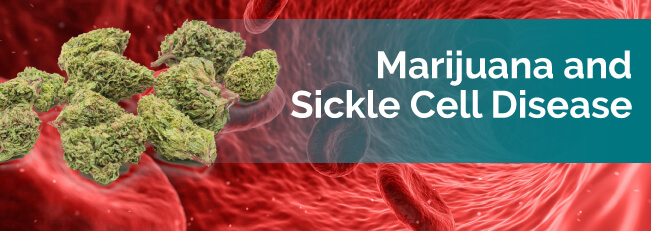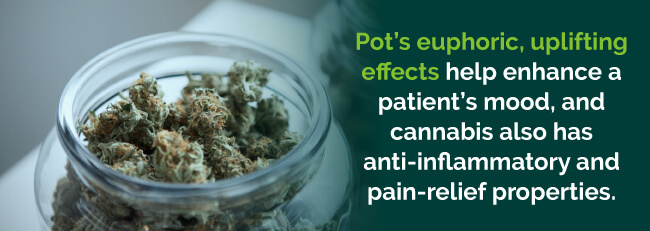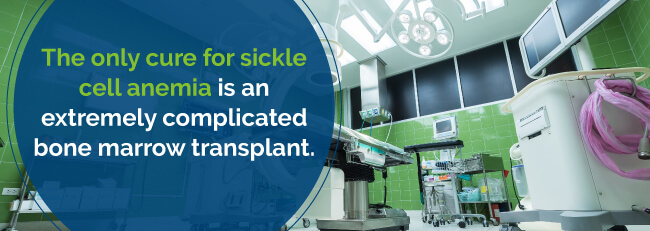
Sickle cell disease refers to a group of heredity disorders affecting the red blood cells. The condition has no cure, so treatment focuses on controlling symptoms, the most common of which is severe pain. If traditional options aren’t efficient at managing the condition, medical cannabis for sickle cell disease is an alternative treatment option.
Medical cannabis for sickle cell disease is growing in acceptance. It is in no way a panacea for all patients, but it has shown to be a versatile, useful medicine for many. Pot’s euphoric, uplifting effects help enhance a patient’s mood, and cannabis also has anti-inflammatory and pain-relief properties as well. Medical marijuana is also a safe, effective alternative to potentially dangerous medications such as opiates.
Find A Doctor Find A Dispensary

It is extremely important to treat the pain associated with the disease for reasons that extend beyond the comfort of the patient. Sickle cell pain can be the result of many different complications, including inflammation as well as blood vessel blockage. When inflammation is reduced, tissue damage can be minimized. This, in turn, will help to improve a patient’s overall health.
Research related specifically to marijuana use for sickle cell disease is limited due to federal regulations, but some studies and surveys have been conducted on the disease. A 2005 study of 86 young adults showed that 36 percent of those surveyed had used marijuana in the previous year to treat sickle cell disease symptoms. Of those who used cannabis, 52 percent said the main reason as for pain relief and 39 percent said it was or relaxation, anxiety relief and to ease depression.
Another study in 2014 at San Francisco General Hospital focused on the use of CBD, a type of non-psychoactive cannabinoid, to treat sickle cell disease. Mice genetically programmed to have sickle cell anemia appeared to have less pain and inflammation with the use of CBD. This shows promise for those suffering from the condition.
Marijuana for sickle cell disease can have a significant effect on the pain. The chemicals in marijuana called cannabinoids work with the natural receptors in the body’s endocannabinoid system. That interaction can ease pain, reduce inflammation and help with many other processes in the body. Pot is known as an analgesic with positive effects on both acute and chronic pain. Because sickle cell disease can cause both types of pain, pot can be effective in controlling pain during and between crises. Its anti-inflammatory properties can also make pot effective in treating sickle cell disease.
Other patients with the condition find the relaxing qualities of cannabis helpful. Since stress can bring on a crisis and patients sometimes feel depression with the condition, marijuana can have a positive effect on those situations.
Relieving the pain, inflammation and depression associated with sickle cell disease can help the patient live a more normal life. The chronic and acute pain is often so severe that it interferes with everyday activities. Finding effective pain relief not only makes the patient more comfortable, but it also improves the overall quality of life and expands the possibilities of activities the patient can do.
It’s always important to see your healthcare provider on a routine basis to manage your sickle cell disease and prevent complications. However, adding medical marijuana to your treatment plan may significantly reduce the pain and inflammation you experience due to the disease.
Some patients use medical marijuana exclusively to treat the pain. Others use it in addition to opiates and other prescribed medications. Using marijuana may enable you to reduce the amount of opiates required to keep your pain under control. Additionally, opiates can sometimes cause nausea. Because marijuana often helps reduce nausea, it can be a good balance if you continue taking opiates.
An experienced medical marijuana doctor can help you create a treatment plan that incorporates cannabis. Choosing a strain of marijuana that is effective can take some time. CBD is a non-psychoactive cannabinoid that is thought to help with pain and inflammation. If you want the analgesic and anti-inflammatory effects without a string high, choose a strain that is high in CBD and low in THC.
Another factor is how you want to feel. Indica-dominant strains leave you feeling more relaxed and sleepy. Use these strains at night or when you want to rest. They can help you relieve pain and fall asleep easier, so you can get the rest you need. Sativa-dominant strains of marijuana tend to be uplifting or energizing. These strains work well during the day when you need to have energy while still receiving the pain-relieving and anti-inflammatory effects.
The method of delivery is also a consideration when treating sickle cell disease with marijuana. When you experience the severe, acute pain associated with sickle cell disease, you want fast relief. Smoking and vaporizing are two ingestion methods that both provide almost instant effects, making them ideal for those sudden crises.
While similar, there are some differences between the methods. Smoking uses a high heat point that causes combustion. That combustion also creates byproducts that can be harmful. Some users prefer to avoid the potential respiratory effects that come with smoking marijuana.
Vaporizing requires a much lower heat point to release the chemicals. Breathing in the vapors gives you the same relief without as many byproducts as smoking.
The effects of smoking or vaporizing marijuana happen quickly, but they don’t last as long as some other methods. Edibles infused with cannabis have a longer-lasting effect, providing you with longer relief. The drawback is that using marijuana edibles takes longer to feel the initial effects. You may have to wait anywhere from 30 minutes to a few hours to feel the relief. However, the longer relief period makes edibles appealing at night, so you can sleep through the night without pain.
Topical application is another option for sickle cell disease. Lotions, creams and other topical applications can let you target a specific area.
Working with your medical marijuana doctor to decide on the strain and ingestion method is important in finding relief. You may decide to use different strains at different times of day. You might also use different ingestion methods, depending on the situation or time of day.
While cannabis for sickle cell disease pain is an effective alternative treatment, it’s important to understand the potential side effects. When compared to opiates, the side effects are mild. When the marijuana leaves your system, those effects also go away, so you won’t deal with long-term effects the way you may with prescription drugs.
Some of the potential effects you may feel when using marijuana include:
While some of the effects may be slightly annoying, others can be beneficial. For example, if you have a low appetite, you might find increased hunger to be a positive effect. If you aren’t sleeping well, the drowsiness may improve your sleep.
The laws pertaining to the conditions that can be treated with medical cannabis are varied and often confusing. Certain states allow it for some conditions, while not allowing it for others. As of this writing, only Connecticut, Georgia, Ohio and Pennsylvania list sickle cell among the qualifying conditions that can be treated with medical weed. Massachusetts, the state of Washington and Washington D.C. allow the use of marijuana as a treatment for sickle cell as long as it is recommended by a physician.
If you would like to learn more about the benefits of medical cannabis for sickle cell disease, we can help you find experienced medical marijuana doctors in all legal marijuana states. Visit MarijuanaDoctors.com to find a marijuana doctor in your area. Learn about how cannabis can help reduce the pain and inflammation of sickle cell disease, so you can start living a more productive life.
Find A Doctor Find A Dispensary
Sickle cell disease is a hereditary condition, meaning it is passed from the parents to the child. The group of disorders affects the hemoglobin in the red blood cells, causing changes in the shape and functioning on the hemoglobin. This can create problems with blood flow, which limits oxygen in nearby tissues.
The condition causes the body’s red blood cells to become sticky and misshapen. When this happens, they cannot perform their function of transporting oxygen. While healthy red blood cells are flexible and round, enabling them to travel through blood vessels easily, sickle cells are more the shape of a crescent moon and also rigid. They are, as a result, more prone to become wedged in blood vessels, leading to limited or blocked circulation.
These blockages make it difficult for the blood to carry oxygen to tissues in the body. Because of the decreased oxygen reaching the tissue, the patient may experience sudden severe pain attacks, referred to as pain crises. Over time, that lack of oxygen can cause damage to various organs. The most common parts of the body affected by this long-term damage include the spleen, brain, heart, lungs, eyes, liver, kidneys, penis, skin, bones and joints.
Because the cells are rigid and don’t change shape well, they often burst apart easily. This shortens the life of the cells significantly. Normally, the red blood cells would last 90 to 120 days. In patients with sickle cell disease, red blood cells typically only live 10 to 20 days before bursting. Because of this short lifespan of the red blood cells, the body has difficulty replacing the cells at a fast enough pace, resulting in a lower than normal red blood count. This leads to sickle cell anemia, the most common disorder in the sickle cell disease family.
You inherit sickle cell disease when both parents have the abnormal hemoglobin gene. You receive one of these abnormal genes from each parent. At least one of the two inherited abnormal genes causes the production of hemoglobin S. If you have two of the hemoglobin S genes, this causes sickle cell anemia.
If only one parent has the abnormal gene, it gets passed on to the child, who then becomes a carrier. It is possible for some sickle cells to develop in the child’s blood. However, the child generally won’t have symptoms. The gene is still passed on to the carrier’s children.
Patients with sickle cell disease have it from birth. Issues associated with the disease don’t typically occur until around five or six months.

Estimates suggest that about 100,000 people have the disease in the United States. Sickle cell disease most commonly affects African Americans, with one in 13 babies of African American descent having the sickle cell trait and one in 365 being born with the disease. People of other ethnicities can also have the trait or the disease.
The symptoms and the severity of sickle cell disease vary significantly depending on the patient. The symptoms may change over time and often relate to complications caused by the disease. Pain is the most prominent symptom in many patients, and it most often happens in the chest, abdomen, lower back, legs, arms and joints. Some patients also experience pain in the bones. Certain conditions can trigger a pain crisis, including illness, stress, change in temperature, dehydration and high altitude.
The nature of the pain can vary from one person to the next and even from one episode to the next in the same person. Patients may feel sharp, stabbing or throbbing pain. The pain sometimes lasts only a few hours. Other patients experience the pain for weeks at a time. Young patients often don’t have pain between crises. However, adolescents and adults with the condition sometimes do experience this. The chronic pain is often due to damage to the bones and joints, ulcers and other effects of the disease.
Other potential symptoms include:
People who have sickle cell anemia are at a much higher risk of deadly infections, as well as heart attacks and strokes. They also tend to be at an increased risk of blood clots, eye problems, liver problems, kidney damage, leg ulcers, pulmonary hypertension, blindness, gallstones and several other serious problems.

Sickle cell disease can also cause complications during pregnancy with an increased risk of miscarriage, premature birth and underweight babies. A pregnant mother also has a higher risk of infection, blood clots, high blood pressure and an increase in pain episodes.
The life expectancy of someone with sickle cell disease has increased significantly over the last several decades. The average lifespan was only 14 years in the U.S. in 1973. Now, that average life expectancy has increased to 40 to 60 years, mostly due to improved methods of diagnosing the disease and treating the condition one it’s diagnosed. Early diagnosis is a crucial component to treating the condition effectively and extending one’s life.
Diagnosis occurs with a simple blood test that looks for hemoglobin S. If it is present, additional testing occurs to determine if the patient has one or two defective genes. All newborns have this blood test performed at the hospital, which means most people are diagnosed at birth. Doctors can also perform prenatal screenings by taking a sample of amniotic fluid or tissue from the placenta to look for the abnormal hemoglobin gene.
The only cure for sickle cell anemia is an extremely complicated bone marrow transplant called hematopoietic stem cell transplantation (HSCT). It is difficult to perform because it is hard to find appropriate donors. The best match is a donor who is related and doesn’t have sickle cell disease. Only about one in 10 kids with the condition have a related matched donor without the condition. Another issue is the patient’s age. Many patients are too old to have the transplant. Sixteen is generally the cutoff for this treatment option, as older patients have significantly higher risks that accompany the procedure. Doctors typically only recommend the transplant for children with major problems associated with the disease.

To receive the transplant, the patient must undergo radiation or chemotherapy to get rid of bone marrow stem cells. Healthy donor stem cells are injected into the bloodstream and eventually enter the bone marrow, where they form new blood cells.
The success rate in children who receive the transplant from a matched donor who is related is 85 percent. However, some patients’ bodies reject the donor stem cells even with medications designed to prevent rejection. When this happens, the patient can face life-threatening complications.
There are several treatment options that focus on prolonging life and managing symptoms. Doctors often prescribe antibiotics to fight infections and medications to address pain. Some patients take antibiotics for extended periods to prevent infections. This treatment is often the case for kids from about two months through five years old. An adult who has previously had pneumonia or who has had the spleen removed may also need to take antibiotics regularly.
Another medication, Hydroxyurea, is sometimes effective in helping to prevent sickle-shaped cells from forming, as well as reducing pain. It encourages the body to produce fetal hemoglobin which is typically found in newborns and prevents the sickle cell formation. The drug may reduce blood transfusions and hospitalizations. However, it can lead to severe side effects that include dizziness, loss of hair, vomiting, loss of appetite and many other potential issues. It may also increase the risk of infection, which is already high due to the sickle cell disease.
Because pain is a common symptom of the disease, many patients are prescribed pain relievers. These medications may include opiates, which are highly addictive. Other side effects of opiates include loss of appetite, nausea, constipation and sedation.
Children with sickle cell disease may undergo a painless screening using a transcranial ultrasound machine to assess the risk of stroke, which can occur due to blood blockage. If the child has a higher risk of stroke, the doctor may order regular blood transfusions to help decrease that risk.
Blood transfusions can also help with other aspects of sickle cell disease. The transfusion can relieve some symptoms of anemia by introducing a higher number of normal red blood cells. Transfusions also help treat and prevent complications of the disease. Because transfusions can cause excessive iron in the blood, some patients may need medication to minimize iron levels to prevent damage to organs.
Vaccinations are also important in children with sickle cell anemia due to the increased risk of infection. Doctors may also recommend influenza, pneumococcus and meningococcal vaccinations.